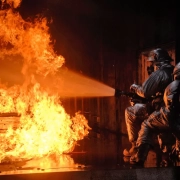MACSEA and PacMar Patent Pending for Fire Prevention System
Last year, MACSEA Ltd and PacMar Technologies formed a strategic partnership to develop advanced infrared monitoring technologies for fire prevention in marine and industrial applications. Through a Joint Development Agreement, the two companies recently filed a provisional patent application for a Fire Monitoring and Detection System. Advanced fire detection systems integrate thermal and RGB image data with AI machine learning models to enhance fire monitoring in large, complex, or inaccessible environments. These systems utilize multiple sensors, including cameras and fiber-optic cables, to detect thermal anomalies, smoke, and flames more accurately, reducing false alarms and improving response times.
- Multi-modal fire detection: The system uses thermal and RGB image data processed by machine learning models to generate bounding boxes, confidence levels, and classifications for flames and smoke, enabling more confident fire detection and alerts.
- Integration of temperature data: Confidence levels in fire detection are adjusted by evaluating temperature sensor data within detected bounding boxes, enhancing diagnostic accuracy and reducing false alarms.
- Ignition risk assessment via object modeling: Object co-occurrence and graph-based models analyze relationships between detected objects and their ignition risks, triggering alarms when risk thresholds are exceeded.
- Fire growth and proximity analysis: The system tracks changes in bounding box sizes over time to assess fire growth and distinguishes fire expansion from camera movement, supporting timely alarm activation. Proximity between objects is also evaluated to assess fire risk.
- Use of fiber-optic cables for inaccessible areas: Fiber-optic sensors enable temperature monitoring in hard-to-access or EMI-rich environments, providing reliable, non-contact thermal health data without sensor drift.
- Machine learning models for forecasting and anomaly detection: The system employs advanced forecasting algorithms, including LSTM and convolutional neural networks, for predicting temperature-related equipment degradation and fire risks based on time-series thermal data.
- Fire watch support for hot work: Automated fire watch units integrate thermal cameras, AI analytics, fire suppression devices, and alarms to monitor hot work areas, reducing occupational hazards and increasing safety.
- Scalable, autonomous architecture: The fire detection system supports deployment across various industries and environments, including maritime, manufacturing, and residential, with flexible hardware configurations and integration capabilities.


